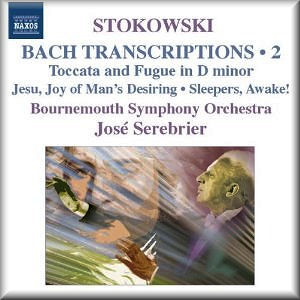 |
 |
| 

alternatively
CD: MDT
AmazonUK
AmazonUS
Sound
Samples & Downloads |
Leopold Stokowski: Symphonic Transcriptions
Vol 2
Johann Sebastian BACH (1685-1750)
Toccata and Fugue in D minor, BWV 565 [9:02]
Harpsichord Concerto in F minor, BWV 1056: Arioso [6:00]
Wachet auf, Chorale Prelude, BWV 645 [3:48]
Ich ruf' zu dir, Herr Jesu Christ: Chorale Prelude,
BWV 639 [3:24]
Toccata, Adagio and Fugue, BWV 564: Adagio [4:01]
Schmelli Song Book: Mein Jesu [3:51]
Ein feste burg (A Mighty Fortress), chorale [2:46]
Cantata No 147: Jesu, Joy of Man's Desiring [3:33]
The Well-Tempered Clavier, Book I: Prelude in B minor [3:54]
Violin Sonata No 4, BWV 1017: Siciliano [2:41]
The Well-Tempered Clavier, Book I: Fugue in C minor [2:04]
Giovanni Pierluigi da PALESTRINA
(1526-1594)
Adoramus te [2:33]
William BYRD (1543-1623)
Pavane and Gigue [4:35]
Jeremiah CLARKE (1674-1707)
Trumpet Prelude [2:23]
Luigi BOCCHERINI (1743-1805)
Quintet in E, Op 13 No 5: Minuet [3:43]
Johann MATTHESON (1681-1764)
Harpsichord Suite No 5: Air [3:48]
Franz Joseph HAYDN (1732-1809)
Quartet in F, Op 3 No 5: Andante cantabile [2:52]
All selections arranged by Leopold Stokowski
 Bournemouth Symphony Orchestra/Josť Serebrier
Bournemouth Symphony Orchestra/Josť Serebrier
rec. Concert Hall, Lighthouse, Poole, April 2008
 NAXOS 8.572050 [64:59]
NAXOS 8.572050 [64:59]
|
|
|
Leopold Stokowski's once-esteemed orchestral transcriptions
- through which many twentieth-century music-lovers first got
to know Bach's keyboard works - faded rapidly in popularity
after the conductor's death. This is partly a matter
of changing tastes, with the clear lines and no-nonsense phrasing
of the "historical performance" movement gradually
supplanting the heavier, self-consciously moulded style previously
favored. A greater obstacle, however, was the absence of the
maestro himself. Stokowski, the orchestrator's distinctive
ear for timbre and texture is, obviously, reflected in the arrangements
themselves. But the particular personality projection of Stokowski
the conductor - the alchemy with which he would draw a unique
and compelling energy from his players - isn't so easily
reproduced. Josť Serebrier, a longtime Stokowski assistant,
at least has the advantage of a longstanding acquaintance with
the "Stokowski sound" and style: even if he can't
replicate the full Stokowski magic, he knows how these arrangements
should "go".
Thus, his account of A Mighty Fortress starts from
a posture of humility, tentatively becoming more affirmative
until, the second time around, it breaks into a full-scaled
paean of praise, much in the maestro's own manner. The
piece labeled simply Arioso - actually the Largo
from the F minor Harpsichord Concerto - unfolds with a sombre
dignity, maintaining it as the textures open up. There's
a real Stokowskian depth and intensity to the string chords
of the Air taken from Johann Mattheson's C minor
harpsichord suite. Both Palestrina's Adoramus te
and the pavane of Byrd's Pavane and Gigue project
a sustained, reverent intensity, with the piquant woodwind staccati
of Byrd's gigue offering a nice contrast. Returning to
Bach, the big C minor Fugue from Book I of The Well-Tempered
Clavier is mostly incisive, and ominous in the climaxes,
but perhaps it also emulates the wrong elements of
the style: it turns lumbering as it heads into the home stretch,
and the final chord doesn't quite land together!
Moments like that in Stokowski's own performances could
make you forget that "his" sound took in refinement
as well as richness. Serebrier acknowledges this in the the
Siciliano from Bach's fourth violin sonata,
where he shapes the secondary parts so as to underline the music's
undulating grace, and in a mobile, but light and gracious, rendering
of Haydn's Andante cantabile, from the F major
Quartet in Op. 3. Serebrier draws from the Boccherini Minuet
a lovely, clear-toned elegance that might have surprised the
older conductor.
Then again, sometimes the arrangements themselves provide the
surprise. The Jeremiah Clarke selection is the piece once attributed
to Henry Purcell, more familiarly known as "Trumpet Voluntary".
It's easy enough to make the piece sound grand; Stokowski
chooses lighter, more transparent orchestral textures, making
it sound more festive, less formal.
The Bournemouth Symphony responds to Serebrier alertly and with
enthusiasm, reproducing all the liquid and sensuous colors of
Stokowski's brilliant palette, and the engineering offers
clarity, depth, and warmth as needed. As you might surmise,
I enjoyed this immensely - it's excellent value even
at Naxos's new mid-priced status.
Stephen Francis Vasta
|
|

